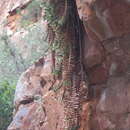mk
имиња во трошки


Gasteria rawlinsonii ist eine Pflanzenart der Gattung Gasteria in der Unterfamilie der Affodillgewächse (Asphodeloideae).
Gasteria rawlinsonii wächst stammbildend und sprosst von der Basis aus. Die hängenden Triebe erreichen eine Länge von bis zu 100 Zentimeter. Die linealischen, bandförmigen, leicht sichelförmigen Laubblätter sind zweizeilig am Trieb angeordnet oder bilden eine Rosette. Ihre Spitzen sind zurückgebogen. Die grüne Blattspreite ist 3 bis 8 Zentimeter lang und 1 bis 2,5 Zentimeter breit. Sie ist nicht gefleckt oder schwach mit weißen Flecken bedeckt. Die Unterseite ist konvex, aber nicht gekielt. Die Epidermis ist rau. Der Blattrand ist spärlich gezahnt oder manchmal unbewehrt. Die Zähnchen werden mit dem Alter schwarz. Die Blattspitze ist stumpf gerundet und trägt ein aufgesetztes Spitzchen.
Der Blütenstand ist eine Rispe und erreicht eine Länge von 10 bis 50 Zentimeter. Die rötlich rosafarbene Blütenhülle ist 16 bis 25 Millimeter lang. Ihr bauchiger Teil ist kugelförmig-ellipsoid oder kugelförmig. Er erstreckt sich über mehr als die Hälfte der Länge der Blütenhülle. Oben ist sie zu einer rosafarbenen oder weißen, gelegentlich grün gestreiften Röhre mit einem Durchmesser von 4 bis 6 Millimeter eingeschnürt.
Die länglich eiförmigen Früchte sind 18 Millimeter lang. Sie enthalten 3 bis 4 Millimeter lange Samen.
Gasteria rawlinsonii ist in der südafrikanischen Provinz Ostkap auf schattigen, fast senkrechten Felswänden aus quarzitischem Sandstein verbreitet.
Die Erstbeschreibung durch Anna Amelia Obermeyer wurde 1976 veröffentlicht.[1]
Gasteria rawlinsonii ist eine Pflanzenart der Gattung Gasteria in der Unterfamilie der Affodillgewächse (Asphodeloideae).
Gasteria rawlinsonii is succulent plant of the genus Gasteria native to South Africa.
It is one of the most unusual of the Gasteria species, as it grows long leafy stems of up to 2 meters, which often hang down. It is also unusual in that its leaves are sometimes edged with tiny black teeth, unlike other Gasteria species.
One variety has distichous leaves, while in another the leaves spiral.
The inflorescences have pink flowers, and appear throughout the year, but mainly in Spring (between August and October).
This species is restricted to the Baviaanskloof mountains, in the Willowmore District of the Eastern Cape, South Africa.
Here it tends to grow hanging on cliff faces in shady ravines, growing in well-drained sandstone soils, usually on the shady south-facing cliffs. Rainfall is sparse (c.200–300 mm per annum), and occurs slightly more in the summer. The surrounding habitat is Albany thicket.
It has become popular in cultivation, as a slow-growing ornamental plant, for semi-shade landscaping.[1]
Recent phylogenetic studies have suggested that this species, with the smallest genome of any member of Gasteria, is likely a unique and primitive outlier in the genus, relatively distinct from the other species.
This possibility is supported by its natural habitat being in the centre of the wider distribution of Gasteria, and by a range of other differences that make this species unique in its genus. It is unique in its growth habit; its leaves are sometimes toothed; it does not easily propagate by leaf-cuttings; and it has no leaf maculation.[2]
Natural variation in the wild have resulted in several cultivars:
Gasteria rawlinsonii is succulent plant of the genus Gasteria native to South Africa.
Gasteria rawlinsonii là một loài thực vật có hoa trong họ Măng tây. Loài này được Oberm. mô tả khoa học đầu tiên năm 1976.[1]
Gasteria rawlinsonii là một loài thực vật có hoa trong họ Măng tây. Loài này được Oberm. mô tả khoa học đầu tiên năm 1976.